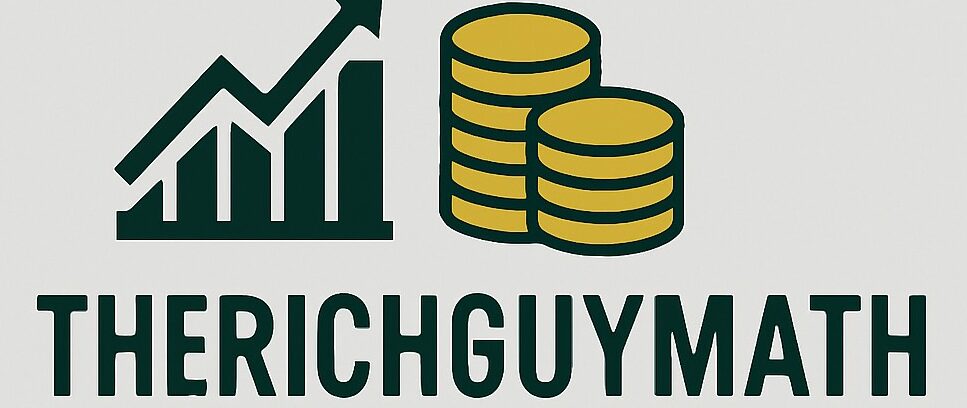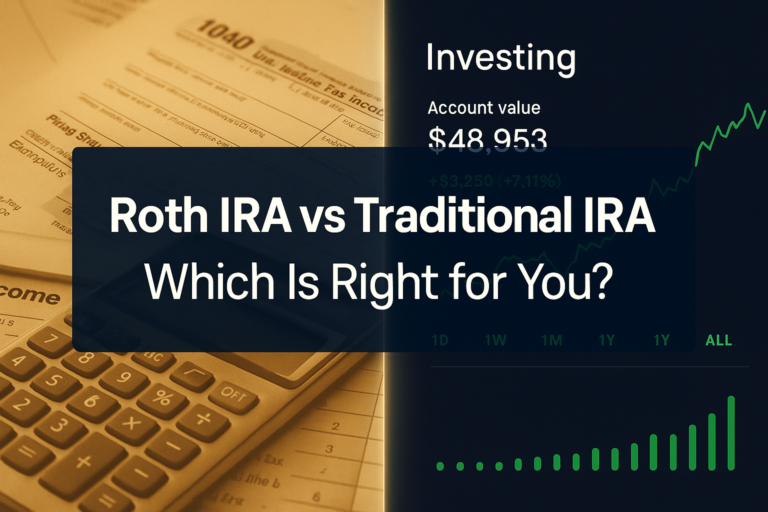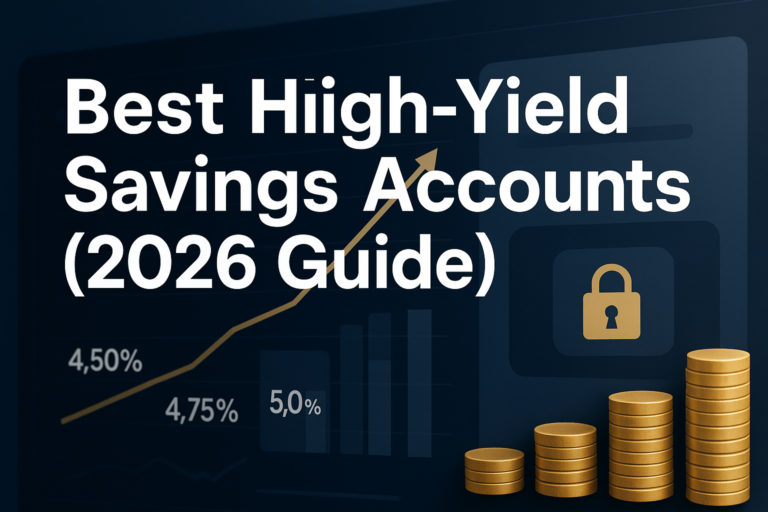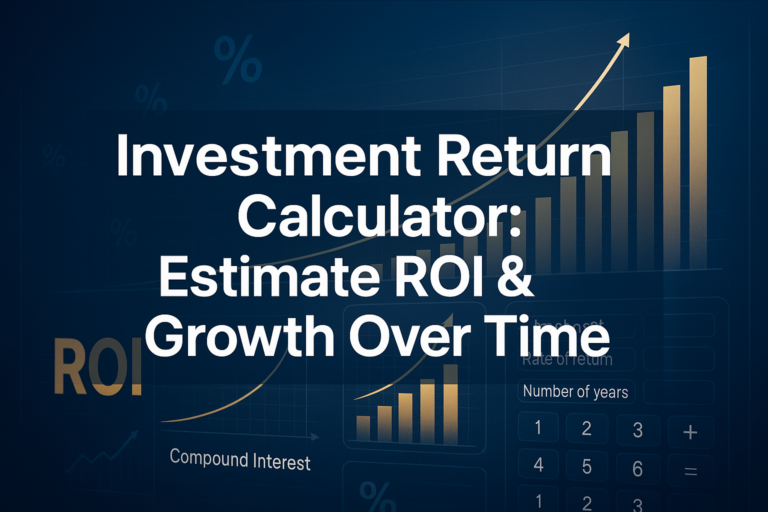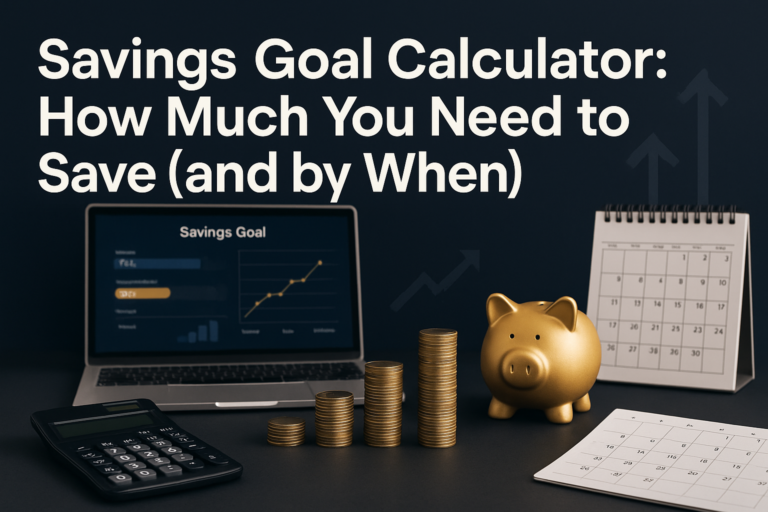Key Takeaways
- Dividend yield measures annual dividend income as a percentage of stock price, calculated by dividing annual dividends per share by the current stock price
- The formula is simple: Dividend Yield = (Annual Dividends Per Share ÷ Current Stock Price) × 100
- Higher yields aren’t always better—extremely high yields often signal financial distress or unsustainable payout ratios
- Dividend yield changes daily as stock prices fluctuate, requiring regular monitoring for accurate income projections
- Combining dividend yield analysis with payout ratio, dividend growth rate, and company fundamentals creates a complete evaluation framework
What Is Dividend Yield?
Dividend yield represents the annual dividend income an investor receives relative to the stock’s current market price, expressed as a percentage. This metric functions as the income return on your investment, separate from any capital appreciation.
Think of dividend yield as the interest rate on a savings account, but for stocks. If a company pays $4 in annual dividends and its stock trades at $100, the dividend yield is 4%. This means for every $100 invested, you receive $4 in annual income.
The cause-and-effect relationship is direct: As stock prices rise, dividend yields fall (assuming dividends remain constant). Conversely, when stock prices decline, dividend yields increase. This inverse relationship creates opportunities for value-conscious dividend investors who can identify quality companies temporarily trading at depressed prices.
Financial institutions and analysts use dividend yield as a primary screening tool when building income-focused portfolios. The metric provides immediate insight into income generation potential, making it essential for retirees, passive income seekers, and conservative investors to prioritize cash flow over growth.
The Dividend Yield Formula Explained
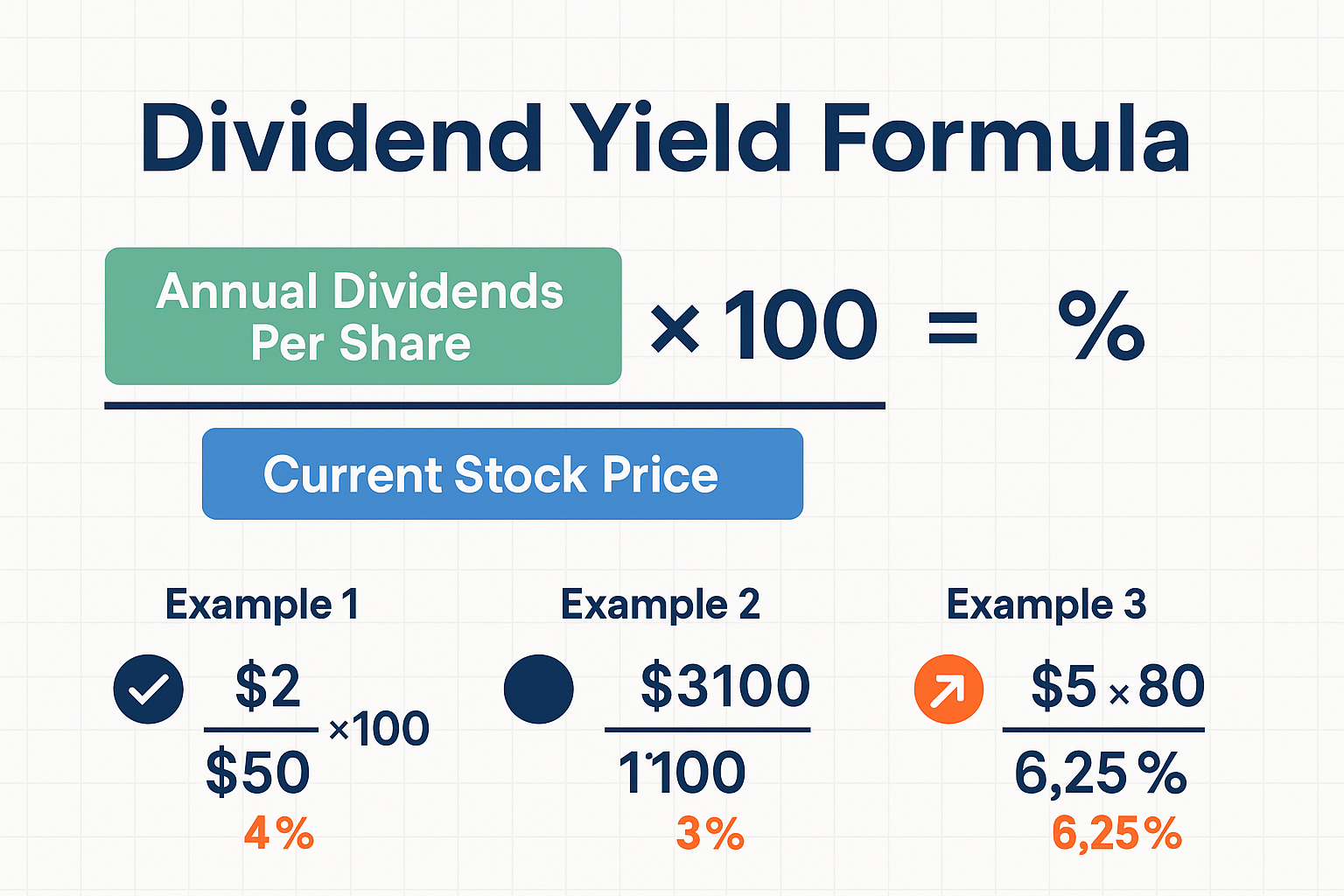
The dividend yield calculation requires just two data points: annual dividends per share and current stock price. The formula is:
Dividend Yield = (Annual Dividends Per Share ÷ Current Stock Price) × 100
Let’s break down each component:
Annual Dividends Per Share
This represents the total dividend payments a company distributes per share over one year. Companies typically pay dividends quarterly, so you’ll multiply the quarterly dividend by four. Some companies pay monthly (multiply by 12) or semi-annually (multiply by 2).
For example, if a company pays a quarterly dividend of $0.50 per share, the annual dividend is $2.00 per share ($0.50 × 4 = $2.00).
Current Stock Price
This is the current market price at which the stock trades. Stock prices fluctuate throughout each trading day, which means the dividend yield also changes constantly.
If that same stock trades at $50 per share, the calculation becomes:
Dividend Yield = ($2.00 ÷ $50) × 100 = 4%
Why We Multiply by 100
Multiplying by 100 converts the decimal result into a percentage, making it easier to compare across different investments and understand the income return intuitively.
Insight: The formula’s simplicity is deceptive. While the math is straightforward, interpreting the result requires understanding company fundamentals, industry context, and sustainability metrics—which we’ll explore in detail.
How to Calculate Dividend Yield: Step-by-Step Process
Calculating dividend yield becomes second nature once you understand the systematic approach. Here’s the complete process:
Step 1: Identify the Annual Dividend Payment
Start by finding the company’s most recent dividend payment. This information is available on financial websites, company investor relations pages, or brokerage platforms.
Important: Verify whether the listed dividend is quarterly, monthly, or annual. Most U.S. companies pay quarterly dividends.
If the quarterly dividend is $1.25, calculate the annual dividend:
Annual Dividend = $1.25 × 4 = $5.00 per share
Step 2: Find the Current Stock Price
Check the current trading price of the stock. This changes throughout the trading day, so use the most recent price for accuracy.
Let’s say the stock currently trades at $125 per share.
Step 3: Apply the Formula
Insert your values into the dividend yield formula:
Dividend Yield = ($5.00 ÷ $125) × 100
Dividend Yield = 0.04 × 100
Dividend Yield = 4%
Step 4: Verify Your Calculation
Double-check your math and ensure you’ve used annual (not quarterly) dividends. A common beginner mistake is using the quarterly dividend amount without multiplying by four, resulting in a yield that’s 75% too low.
Step 5: Compare and Contextualize
Compare your calculated yield against:
- The company’s historical dividend yield
- Industry average dividend yields
- Broader market yields (S&P 500 average is approximately 1.5-2%)
- Alternative income investments like bonds or REITs
Takeaway: The calculation itself takes seconds. The real work lies in interpreting whether that yield represents genuine value or a warning signal.
Real-World Examples of Dividend Yield Calculations
Let’s examine actual scenarios to demonstrate how to calculate dividend yield across different situations:
Example 1: Blue-Chip Dividend Stock
Company: Johnson & Johnson (hypothetical current data)
- Quarterly Dividend: $1.13
- Annual Dividend: $1.13 × 4 = $4.52
- Current Stock Price: $160
Calculation:
Dividend Yield = ($4.52 ÷ $160) × 100 = 2.83%
Analysis: This moderate yield is typical for stable, blue-chip companies with consistent dividend growth. While not spectacular, it’s paired with reliability and potential dividend increases over time.
Example 2: High-Yield Dividend Stock
Company: Altria Group (hypothetical current data)
- Quarterly Dividend: $0.94
- Annual Dividend: $0.94 × 4 = $3.76
- Current Stock Price: $45
Calculation:
Dividend Yield = ($3.76 ÷ $45) × 100 = 8.36%
Analysis: This high yield might attract income seekers, but requires investigation. Is the business stable? Is the payout sustainable? High yields often accompany higher risk or declining business prospects.
Example 3: Dividend Growth Stock
Company: Microsoft (hypothetical current data)
- Quarterly Dividend: $0.68
- Annual Dividend: $0.68 × 4 = $2.72
- Current Stock Price: $380
Calculation:
Dividend Yield = ($2.72 ÷ $380) × 100 = 0.72%
Analysis: This low yield reflects a growth-oriented company. While current income is minimal, the dividend has grown rapidly over time, and total returns include substantial capital appreciation.
Example 4: Monthly Dividend REIT
Company: Realty Income Corporation (hypothetical current data)
- Monthly Dividend: $0.25
- Annual Dividend: $0.25 × 12 = $3.00
- Current Stock Price: $62
Calculation:
Dividend Yield = ($3.00 ÷ $62) × 100 = 4.84%
Analysis: REITs typically offer higher yields because they’re required to distribute 90% of taxable income to shareholders. Monthly payments provide consistent cash flow for income-focused investors.
These examples demonstrate that dividend yield alone doesn’t tell the complete story. Context, sustainability, and growth potential matter equally when evaluating dividend stocks.
Understanding What Different Dividend Yields Mean
Dividend yields fall into distinct ranges, each carrying different implications for investors:
Low Yield (0-2%)
Characteristics:
- Typical of growth companies reinvesting profits
- Common among the technology and biotech sectors
- Often accompanied by strong capital appreciation potential
- Lower immediate income but potential for dividend growth
Investor Profile: Growth-oriented investors who prioritize total return over current income.
Moderate Yield (2-4%)
Characteristics:
- Balanced approach between income and growth
- Common among established blue-chip companies
- Generally sustainable with room for dividend increases
- Aligns with historical S&P 500 average yields
Investor Profile: Balanced investors seeking both income and capital appreciation, similar to strategies discussed in dividend investing guides.
High Yield (4-6%)
Characteristics:
- Attractive for income-focused portfolios
- Common among REITs, utilities, and mature industries
- Requires verification of payout sustainability
- May indicate market concerns about business prospects
Investor Profile: Income-focused investors willing to accept moderate risk for higher current income.
Very High Yield (6%+)
Characteristics:
- Often signals market skepticism or distress
- May indicate unsustainable payout ratios
- Could represent a value opportunity if fundamentals are sound
- Requires thorough due diligence
Investor Profile: Experienced investors capable of analyzing business fundamentals and identifying value versus value traps.
Critical Insight: A 10% dividend yield isn’t automatically superior to a 3% yield. The higher yield might reflect market expectations of a dividend cut, business deterioration, or bankruptcy risk. Always investigate why a yield is high before assuming it represents an opportunity.
Factors That Affect Dividend Yield
Understanding what influences dividend yield helps investors anticipate changes and make informed decisions:
Stock Price Fluctuations
Since dividend yield equals annual dividends divided by stock price, price movements directly impact yield. A 10% stock price decline increases yield by approximately 11% (assuming constant dividends).
Example: A stock paying $3 annually at $60 yields 5%. If the price drops to $50, the yield rises to 6%.
This inverse relationship creates a self-correcting mechanism. As yields rise due to price declines, the stock becomes more attractive to income investors, potentially stabilizing the price.
Dividend Payment Changes
Companies regularly adjust dividend payments based on profitability, cash flow, and strategic priorities.
Dividend Increases: When companies raise dividends, yield increases for existing shareholders (based on their original purchase price) but may remain stable or decrease for new investors if the stock price also rises.
Dividend Cuts: Reducing or eliminating dividends causes yield to drop immediately, often accompanied by sharp stock price declines.
Special Dividends: One-time special dividends temporarily inflate annual dividend totals but shouldn’t be included in forward-looking yield calculations.
Market Conditions
Broader market trends influence dividend yields across entire sectors:
- Bull Markets: Rising stock prices compress dividend yields
- Bear Markets: Falling prices inflate dividend yields
- Interest Rate Changes: Rising rates make bonds more competitive, potentially reducing demand for dividend stocks and increasing yields
- Economic Cycles: Recessions may force dividend cuts, while expansions support dividend growth
Company Performance
Financial health directly impacts dividend sustainability:
- Revenue Growth: Expanding revenue supports dividend increases
- Profit Margins: Improving margins creates cash flow for distributions
- Debt Levels: High debt may force dividend cuts to preserve cash
- Cash Flow: Free cash flow determines dividend sustainability better than reported earnings
Monitoring these factors helps investors distinguish between temporarily high yields (opportunities) and permanently high yields (warning signals).
Dividend Yield vs. Total Return: Understanding the Difference
Dividend yield represents only one component of investment returns. Total return combines dividend yield with capital appreciation (or depreciation) to show complete investment performance.
The Total Return Formula
Total Return = (Ending Price – Beginning Price + Dividends) ÷ Beginning Price × 100
Example Comparison
Scenario 1: High-Yield, Low-Growth Stock
- Purchase Price: $50
- Ending Price: $52 (4% appreciation)
- Annual Dividend: $4 (8% yield)
- Total Return: ($52 – $50 + $4) ÷ $50 × 100 = 12%
Scenario 2: Low-Yield, High-Growth Stock
- Purchase Price: $50
- Ending Price: $60 (20% appreciation)
- Annual Dividend: $0.50 (1% yield)
- Total Return: ($60 – $50 + $0.50) ÷ $50 × 100 = 21%
Despite the lower dividend yield, Scenario 2 delivered superior total returns through price appreciation.
When Dividend Yield Matters Most
Dividend yield becomes the primary consideration for:
- Retirees needing predictable income streams
- Income-focused investors prioritizing cash flow over growth
- Tax-advantaged accounts where dividend taxation isn’t a concern
- Bear market environments, when capital appreciation is limited
When Total Return Takes Priority
Total return becomes more important for:
- Accumulation phase investors reinvest all dividends
- Tax-sensitive accounts where capital gains receive preferential treatment
- Long-term wealth building where compounding drives results
- Growth-oriented portfolios accepting lower current income for appreciation potential
Insight: The optimal approach balances both metrics. Dividend growth stocks offer moderate current yields with consistent dividend increases, delivering attractive total returns through both income and appreciation.
How to Calculate Dividend Yield for Portfolio Planning
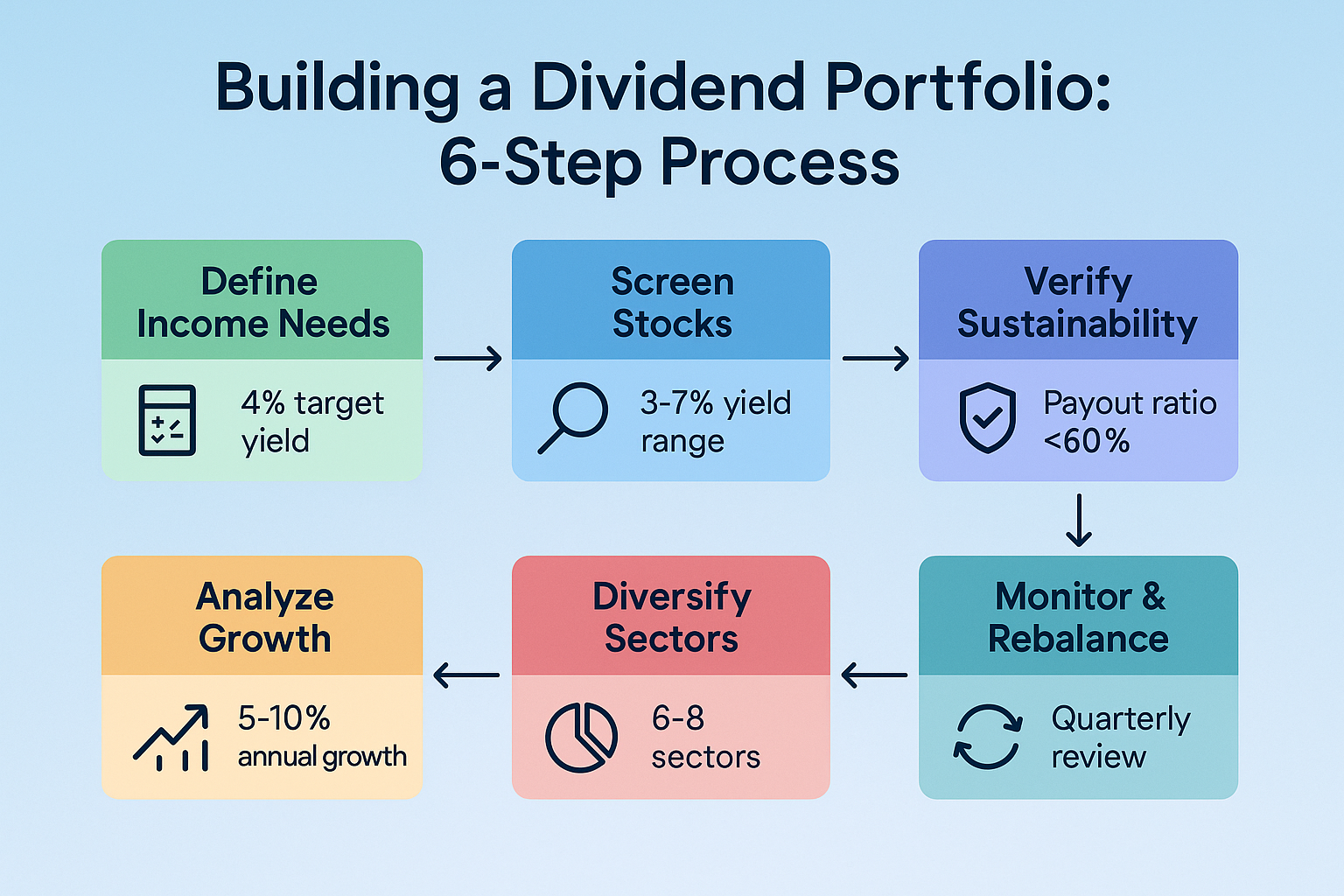
Applying dividend yield calculations to portfolio construction requires systematic analysis:
Step 1: Define Income Requirements
Calculate your annual income needs from dividends. If you need $40,000 annually from a $1,000,000 portfolio, you require a 4% average yield.
This connects to broader financial planning principles like the 4% rule for retirement withdrawals.
Step 2: Screen for Appropriate Yields
Use stock screeners to filter companies meeting your yield requirements. Set minimum and maximum thresholds—for example, 3-7% yields to avoid both low-income stocks and potentially distressed high-yielders.
Step 3: Verify Sustainability
For each candidate, calculate the payout ratio:
Payout Ratio = (Annual Dividends Per Share ÷ Earnings Per Share) × 100
Payout ratios below 60% generally indicate sustainable dividends with room for growth. Ratios above 80% suggest a limited safety margin.
Step 4: Analyze Dividend Growth
Calculate the dividend growth rate over 5-10 years:
Dividend Growth Rate = [(Current Dividend ÷ Past Dividend)^(1/Years) – 1] × 100
Consistent 5-10% annual dividend growth compounds income substantially over time.
Step 5: Diversify Across Sectors
Spread investments across multiple sectors to reduce concentration risk. Different industries offer varying yield profiles:
| Sector | Typical Yield Range | Characteristics |
|---|---|---|
| Technology | 0-2% | Low yield, high growth potential |
| Consumer Staples | 2-3.5% | Moderate yield, stable dividends |
| Utilities | 3-5% | Higher yield, regulated businesses |
| REITs | 3-6% | High yield, required distributions |
| Financials | 2-4% | Moderate yield, cyclical |
| Healthcare | 1.5-3% | Lower yield, defensive characteristics |
Step 6: Monitor and Rebalance
Dividend yields change as stock prices fluctuate. Quarterly reviews ensure your portfolio maintains target yield levels and identifies opportunities to upgrade holdings.
Takeaway: Portfolio-level dividend yield equals the weighted average of individual holdings. A diversified portfolio of 20-30 dividend stocks typically yields 3-5% while maintaining growth potential and risk management.
Common Mistakes When Calculating Dividend Yield
Avoiding these frequent errors ensures accurate analysis and better investment decisions:
Mistake 1: Using Quarterly Instead of Annual Dividends
Error: Calculating yield using only the quarterly dividend payment without multiplying by four.
Example: A stock paying $0.75 quarterly at $50 per share.
- Incorrect: ($0.75 ÷ $50) × 100 = 1.5%
- Correct: ($3.00 ÷ $50) × 100 = 6%
Solution: Always annualize dividend payments before calculating yield.
Mistake 2: Including Special Dividends in Calculations
Error: Treating one-time special dividends as recurring income.
Example: A company pays regular quarterly dividends of $0.50 plus a special $2.00 dividend.
- Annual regular dividends: $2.00
- One-time special: $2.00
- Total paid this year: $4.00
Solution: Calculate yield using only regular recurring dividends ($2.00), not the total $4.00, for accurate forward-looking projections.
Mistake 3: Ignoring Yield Changes Due to Price Fluctuations
Error: Assuming dividend yield remains constant over time.
Reality: Stock prices change daily, causing yield to fluctuate even with stable dividend payments.
Solution: Recalculate yield regularly and understand that your “yield on cost” (based on purchase price) differs from current market yield.
Mistake 4: Chasing Extremely High Yields Without Investigation
Error: Assuming higher yields always represent better investments.
Reality: Yields above 8-10% often signal:
- Imminent dividend cuts
- Deteriorating business fundamentals
- Market skepticism about sustainability
- Potential bankruptcy risk
Solution: Investigate why a yield is high. Analyze payout ratios, cash flow trends, debt levels, and industry conditions before investing.
Mistake 5: Comparing Yields Across Different Investment Types
Error: Directly comparing stock dividend yields to bond yields without considering risk differences.
Reality: Stocks carry a higher risk than bonds. A 4% dividend yield on a stock isn’t equivalent to a 4% bond yield because:
- Stock dividends can be cut or eliminated
- Stock prices fluctuate significantly
- Stocks lack maturity dates and principal guarantees
Solution: Compare dividend stocks to other dividend stocks, and bonds to other bonds. Understand that higher stock yields compensate for additional risk.
Mistake 6: Forgetting Tax Implications
Error: Ignoring that dividend taxation reduces actual returns.
Reality: Qualified dividends face 0%, 15%, or 20% federal tax rates depending on income. Non-qualified dividends are taxed as ordinary income.
Solution: Calculate after-tax yield for accurate return comparisons, especially when comparing to tax-advantaged investments.
Insight: These mistakes compound over time, leading to poor stock selection and disappointing portfolio performance. Systematic attention to calculation accuracy and contextual interpretation separates successful dividend investors from disappointed ones.
Advanced Dividend Yield Concepts
Beyond basic calculations, sophisticated investors employ advanced metrics for deeper analysis:
Yield on Cost (YOC)
Yield on cost measures dividend yield based on your original purchase price rather than the current market price.
Formula: YOC = (Current Annual Dividend ÷ Original Purchase Price) × 100
Example: You purchased a stock at $50 that paid $2 annually (4% yield). Ten years later, the dividend has grown to $4 annually, though the stock now trades at $120.
- Current Market Yield: ($4 ÷ $120) × 100 = 3.33%
- Your Yield on Cost: ($4 ÷ $50) × 100 = 8%
YOC demonstrates the power of dividend growth investing. Your personal yield doubles while market yield remains moderate, creating substantial income growth over time.
Forward Dividend Yield
Forward yield uses projected future dividends rather than past payments.
Formula: Forward Yield = (Estimated Next 12 Months Dividends ÷ Current Price) × 100
Application: If a company just announced a dividend increase from $2.00 to $2.20 annually, the forward yield uses $2.20 even though historical data shows $2.00.
Forward yield provides more accurate projections for companies with growing dividends, though it requires estimation and carries uncertainty.
Dividend Yield Spread
This metric compares stock dividend yields to risk-free rates (typically 10-year Treasury yields).
Formula: Dividend Yield Spread = Stock Dividend Yield – 10-Year Treasury Yield
Example:
- Stock Dividend Yield: 4%
- 10-Year Treasury Yield: 3.5%
- Dividend Yield Spread: 0.5%
Wider spreads suggest stocks offer better relative value compared to bonds. Narrow or negative spreads might indicate overvaluation or that bonds provide competitive returns with lower risk.
Sector-Adjusted Dividend Yield
Comparing a stock’s yield to its sector average reveals relative attractiveness.
Example:
- Company A Yield: 3.5%
- Technology Sector Average: 1.5%
- Company A offers 2% premium to the sector average
This context matters because a 3.5% yield is high for technology but low for utilities, where sector averages might reach 4-5%.
Dividend Coverage Ratio
This measures how many times earnings cover dividend payments.
Formula: Dividend Coverage = Earnings Per Share ÷ Dividends Per Share
Interpretation:
- Ratio > 2: Very safe, substantial cushion
- Ratio 1.5-2: Comfortable, room for growth
- Ratio 1-1.5: Adequate, limited margin
- Ratio < 1: Unsustainable, dividend at risk
Higher coverage ratios indicate greater dividend safety and potential for future increases.
These advanced concepts provide a nuanced understanding beyond simple yield calculations, enabling more sophisticated portfolio construction and risk assessment. They’re particularly valuable when evaluating dividend aristocrats and other quality dividend stocks.
Dividend Yield in Different Market Conditions
Market environments significantly impact dividend yield attractiveness and interpretation:
Bull Markets
Characteristics:
- Rising stock prices compress dividend yields
- Income investors face lower yields on new purchases
- Existing holdings show lower current yields but higher YOC
- Growth stocks outperform dividend stocks
Strategy: Focus on dividend growth rather than current yield. Companies increasing dividends 10-15% annually provide income growth even as market yields compress. Consider dollar cost averaging to build positions over time.
Bear Markets
Characteristics:
- Falling prices inflate dividend yields
- Quality dividend stocks become attractively priced
- Some yields rise due to genuine distress (dividend cuts coming)
- Income stocks often decline less than growth stocks
Strategy: Distinguish between rising yields from price declines (opportunity) versus deteriorating fundamentals (danger). Focus on companies with strong balance sheets, low payout ratios, and recession-resistant businesses.
Rising Interest Rate Environments
Characteristics:
- Bonds become more competitive with dividend stocks
- High-yield dividend stocks (utilities, REITs) often underperform
- Dividend growth stocks with pricing power maintain attractiveness
- Dividend yield spreads narrow
Strategy: Emphasize dividend growth over current yield. Companies raising dividends faster than inflation maintain purchasing power regardless of rate environments.
Recession Periods
Characteristics:
- Dividend cuts become more common
- Payout sustainability becomes a critical concern
- Defensive sectors (consumer staples, healthcare) maintain dividends better
- Cyclical sectors (industrials, materials) face pressure
Strategy: Prioritize dividend safety over yield magnitude. Analyze free cash flow, debt levels, and business resilience. Accept lower yields for greater security.
Inflationary Environments
Characteristics:
- Fixed dividend payments lose purchasing power
- Dividend growth becomes essential
- Companies with pricing power can increase dividends above inflation
- Real (inflation-adjusted) yields matter more than nominal yields
Strategy: Focus on businesses with pricing power that can grow dividends faster than inflation. Calculate real yield by subtracting the inflation rate from the dividend yield.
Takeaway: Effective dividend investing requires adapting strategy to market conditions rather than applying static rules. The same 5% yield represents opportunity in one environment and danger in another, depending on sustainability and context.
Tools and Resources for Dividend Yield Analysis
Leveraging quality tools streamlines research and improves decision-making:
Financial Websites
Yahoo Finance (finance.yahoo.com)
- Free access to dividend history, yield data, and payout ratios
- Historical price charts with dividend markers
- Analyst estimates and financial statements
Morningstar (morningstar.com)
- Comprehensive dividend analysis and sustainability ratings
- Dividend growth rates and historical consistency
- Premium features for detailed research
Seeking Alpha (seekingalpha.com)
- Dividend-focused articles and analysis
- Dividend scorecards and safety ratings
- Community insights and discussions
Stock Screeners
Finviz (finviz.com)
- Free screener with dividend yield filters
- Visual charts and comparison tools
- Sector and industry filtering
Portfolio Visualizer (portfoliovisualizer.com)
- Backtesting dividend strategies
- Portfolio optimization tools
- Factor analysis and risk metrics
Brokerage Platforms
Most major brokerages (Fidelity, Schwab, Vanguard, Interactive Brokers) provide:
- Dividend calendars showing payment dates
- Yield calculations and historical data
- Screening tools for dividend stocks
- Portfolio income tracking
Dividend-Specific Resources
Dividend.com
- Dedicated dividend stock research
- Dividend aristocrats and kings lists
- Ex-dividend date calendars
- Educational content
Sure Dividend
- Quality dividend stock analysis
- Dividend growth investing strategies
- Newsletter and research reports
- Stock rankings and ratings
Calculation Tools
Spreadsheet templates (Excel, Google Sheets) allow custom analysis:
- Track personal yield on cost
- Calculate portfolio-level yields
- Model dividend growth scenarios
- Monitor payout ratios and coverage
Creating a personal tracking system helps monitor holdings systematically and identify opportunities for portfolio improvement.
Insight: Combining multiple resources provides a comprehensive perspective. No single tool offers complete information, so cross-referencing data sources improves accuracy and reveals insights individual platforms might miss.
Dividend Yield vs. Other Investment Metrics
Understanding how dividend yield relates to other financial metrics creates a holistic analysis:
Dividend Yield vs. P/E Ratio
Price-to-Earnings (P/E) Ratio = Stock Price ÷ Earnings Per Share
Relationship: Lower P/E ratios often correlate with higher dividend yields because:
- Mature companies with stable earnings trade at lower multiples
- These companies return more profits to shareholders as dividends
- Growth companies with high P/E ratios reinvest earnings rather than distribute them
Example:
- Mature utility: P/E of 12, dividend yield of 5%
- Growth tech stock: P/E of 40, dividend yield of 0.5%
Both metrics together reveal whether a stock is value-oriented (low P/E, high yield) or growth-oriented (high P/E, low yield).
Dividend Yield vs Return on Equity (ROE)
Return on Equity = Net Income ÷ Shareholder Equity × 100
Relationship: Companies with high ROE can sustain higher dividend yields because they generate strong returns on invested capital. Low Return On Equity companies paying high dividends may be returning capital inefficiently.
Ideal Combination: High ROE (15%+) with moderate dividend yield (3-5%) suggests a company generating strong returns while sharing profits with shareholders and retaining enough for growth.
Dividend Yield vs Debt-to-Equity Ratio
Debt-to-Equity Ratio = Total Debt ÷ Shareholder Equity
Relationship: High debt levels threaten dividend sustainability. Companies with debt-to-equity ratios above 2.0 face a greater risk of dividend cuts during downturns.
Warning Sign: High dividend yield combined with high debt often precedes dividend reductions as companies prioritize debt service over shareholder distributions.
Dividend Yield vs Revenue Growth
Revenue Growth Rate = [(Current Revenue – Previous Revenue) ÷ Previous Revenue] × 100
Relationship:
- High revenue growth + low dividend yield = a growth company reinvesting profits
- Low revenue growth + high dividend yield = mature company returning cash
- Low revenue growth + low dividend yield = potential value trap
Optimal Scenario: Moderate revenue growth (5-10%) with moderate dividend yield (3-5%) suggests balanced approach supporting both dividends and business expansion.
Dividend Yield vs Free Cash Flow Yield
Free Cash Flow Yield = (Free Cash Flow Per Share ÷ Stock Price) × 100
Relationship: Free cash flow yield should exceed dividend yield, providing a safety cushion. If dividend yield equals or exceeds FCF yield, the payout is unsustainable.
Example:
- Free Cash Flow Per Share: $5
- Stock Price: $100
- FCF Yield: 5%
- Dividend Yield: 3%
- Safety Margin: 2% (healthy)
This comparison reveals true dividend sustainability better than earnings-based metrics because cash flow represents actual money available for distributions.
Understanding these relationships prevents overreliance on any single metric and creates comprehensive evaluation frameworks. The best dividend investments typically score well across multiple dimensions, not just yield alone.
Practical Tips for Dividend Yield Investing
Applying these actionable strategies improves dividend investing outcomes:
Tip 1: Set Realistic Yield Targets
Establish yield ranges appropriate for your goals and risk tolerance:
- Conservative: 2-4% yields from blue-chip companies
- Moderate: 3-5% yields from established dividend payers
- Aggressive: 5-7% yields from higher-risk sectors (REITs, MLPs, utilities)
Avoid chasing yields above 8% without exceptional due diligence. Most sustainable portfolios yield 3-5% at the portfolio level.
Tip 2: Prioritize Dividend Growth Over Current Yield
A 3% yield growing 10% annually becomes 7.8% yield on cost in 10 years. A static 6% yield remains 6% forever and may face cuts.
Calculation:
- Year 0: 3% yield
- Year 10: 3% × (1.10)^10 = 7.78% yield on cost
Dividend growth compounds income over time, creating superior long-term results compared to high static yields.
Tip 3: Reinvest Dividends During Accumulation Phase
Reinvesting dividends purchases additional shares, accelerating compound growth. A 4% yield reinvested monthly adds approximately 4% more shares annually, creating exponential growth over decades.
This strategy aligns with compound growth principles that drive long-term wealth building.
Tip 4: Monitor Payout Ratios Quarterly
Track the percentage of earnings paid as dividends:
Safe Ranges by Sector:
- Technology: 20-40%
- Consumer Staples: 40-60%
- Utilities: 60-80%
- REITs: 80-95% (required by law)
Rising payout ratios signal potential trouble. Falling ratios indicate growing safety margins and potential for dividend increases.
Tip 5: Diversify Across Dividend Strategies
Combine different dividend approaches:
- Dividend Aristocrats: 25+ years of consecutive increases
- High-Yield: 5-7% yields from stable sectors
- Dividend Growth: Moderate current yield with strong growth
- International: Geographic diversification with foreign dividends
This diversification balances current income, growth potential, and risk management.
Tip 6: Consider Tax Efficiency
Hold dividend stocks in tax-advantaged accounts (IRAs, 401(k)s) when possible to avoid annual dividend taxation. In taxable accounts, prioritize qualified dividends taxed at preferential rates.
Calculate after-tax yields to compare investments accurately:
After-Tax Yield = Dividend Yield × (1 – Tax Rate)
Example:
- 5% dividend yield
- 22% tax bracket
- After-tax yield: 5% × (1 – 0.22) = 3.9%
Tip 7: Use Dividend Calendars
Track ex-dividend dates, payment dates, and declaration dates to:
- Time purchases before ex-dividend dates to receive upcoming payments
- Avoid buying just before ex-dividend dates if capital appreciation is priority
- Plan cash flow from portfolio distributions
Tip 8: Rebalance Based on Yield Drift
As stock prices change, portfolio yields drift from targets. Quarterly rebalancing:
- Trims positions where yields have fallen due to price appreciation
- Adds to positions where yields have risen due to price declines
- Maintains target portfolio yield and risk profile
Takeaway: Successful dividend investing combines mathematical precision with disciplined strategy execution. These practical tips transform theoretical knowledge into actionable investment processes that generate reliable income and long-term wealth.
Conclusion
Understanding how to calculate dividend yield represents a fundamental skill for income-focused investors. The formula itself—annual dividends per share divided by current stock price, multiplied by 100—takes seconds to apply. The real expertise lies in interpreting results, evaluating sustainability, and integrating yield analysis into comprehensive
Author Bio
Max Fonji is a data-driven financial educator and the voice behind The Rich Guy Math. With a background in financial analysis and a passion for teaching evidence-based investing principles, Max helps beginners and intermediate investors understand the mathematical foundations of wealth building. His approach combines rigorous quantitative analysis with clear, accessible explanations that empower readers to make informed financial decisions based on data rather than emotion.
Educational Disclaimer
This article is provided for educational and informational purposes only and does not constitute financial, investment, tax, or legal advice. The information presented represents general principles and historical data that may not apply to your specific financial situation.
Investing in dividend ETFs involves risk, including possible loss of principal. Past performance does not guarantee future results. Dividend payments are not guaranteed and can be reduced or eliminated at the company’s discretion. ETF share prices fluctuate based on market conditions, and you may receive less than your original investment when selling shares.
Before investing, carefully consider your financial objectives, risk tolerance, time horizon, and tax situation. Consult with qualified financial, tax, and legal professionals regarding your specific circumstances. The author and The Rich Guy Math are not registered investment advisors and do not provide personalized investment recommendations.
All data, statistics, and examples are based on historical information and hypothetical scenarios for illustrative purposes. Actual results will vary based on market conditions, individual circumstances, and investment timing.
FAQ
What is a good dividend yield for a stock?
A good dividend yield typically ranges between 2–6%, depending on market conditions and investment goals. Yields of 2–4% are common for stable blue-chip stocks, 4–6% for income-focused sectors such as utilities and REITs, and yields above 6% require closer review for sustainability. Since the S&P 500’s historical average yield is around 1.8–2%, anything above this offers additional income—but yield quality matters more than size. A safe and growing 3% yield often outperforms an unstable 8% yield likely to be cut.
How do you calculate dividend yield from stock price?
Calculate dividend yield by dividing annual dividends per share by the current stock price, then multiplying by 100. Formula: Dividend Yield = (Annual Dividends Per Share ÷ Stock Price) × 100. For example, if a stock pays $3 annually and trades at $75, ($3 ÷ $75) × 100 = 4%. Use annualized dividends (quarterly dividend × 4) and the most recent price for an accurate calculation.
Is a higher dividend yield always better?
No. A higher dividend yield is not always better. Very high yields can indicate dividend danger, deteriorating fundamentals, or expected dividend cuts. A 10% yield may signal that the market expects a significant reduction. High yields may also suggest limited growth or elevated risk. The best approach balances yield, dividend safety, and long-term growth potential—not simply the highest percentage.
How often should I recalculate dividend yield?
Recalculate dividend yield whenever making investment decisions, and review it monthly or quarterly for monitoring. Stock prices move daily, so yields fluctuate constantly. Quarterly reviews align with dividend announcements and earnings releases. After dividend changes (increases or cuts), recalculate immediately. Remember that your personal yield on cost stays constant, but market yield changes with price.
Can dividend yield be negative?
No, dividend yield cannot be negative. A company either pays a dividend (positive yield) or does not (0% yield). What can be negative is total return—if the stock price declines more than the dividend received. For example, a stock yielding 4% but falling 10% creates a -6% total return. Yield itself cannot fall below zero because it represents income divided by price.
What’s the difference between dividend yield and dividend rate?
Dividend rate is the dollar amount of annual dividends paid per share. Dividend yield expresses this dollar amount as a percentage of the stock’s current price. For example, a $4 dividend rate yields 4% at a $100 share price but 5% at an $80 share price. The dividend rate stays constant while the yield fluctuates with stock price changes. Rate helps estimate income; yield allows comparison across stocks.
How does stock price affect dividend yield?
Stock price and dividend yield move inversely. When stock prices rise, yields fall; when prices fall, yields rise—assuming dividends remain constant. A $4 dividend yields 4% at $100, 3.33% at $120, and 5% at $80. This relationship creates opportunities when quality stocks temporarily drop, offering higher yields to new investors while existing shareholders benefit from price appreciation.
Should I focus on dividend yield or total return?
It depends on your financial goals. During accumulation years, total return—dividend yield plus capital appreciation—is typically more important because reinvested dividends compound over time. During retirement or income-focused phases, dividend yield becomes more important because it provides spendable cash flow. A balanced strategy favors stocks with moderate yields (3–5%) and strong dividend growth, supporting both income and long-term returns.
